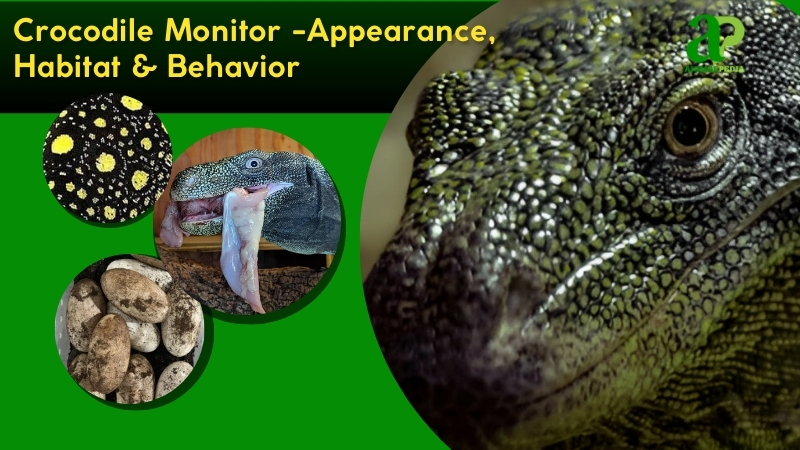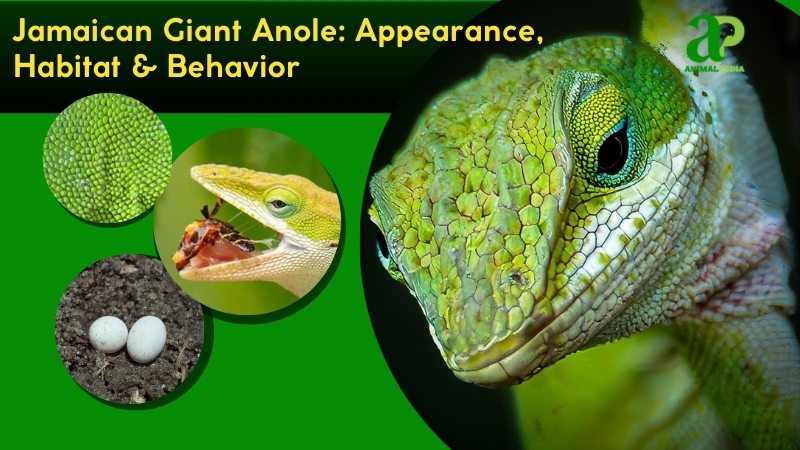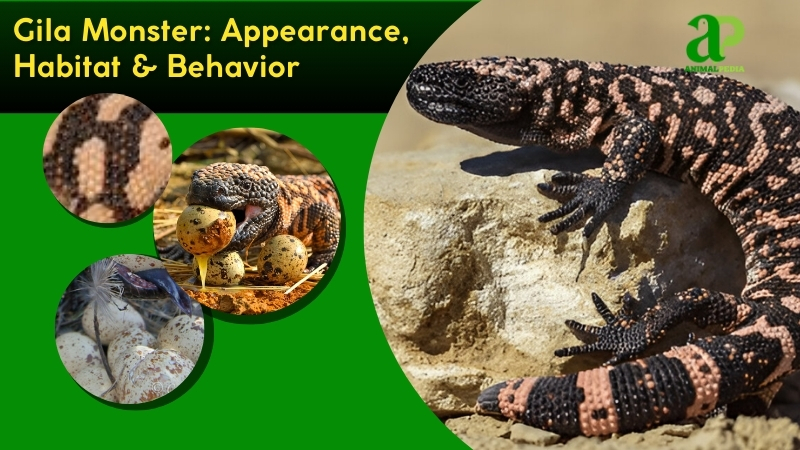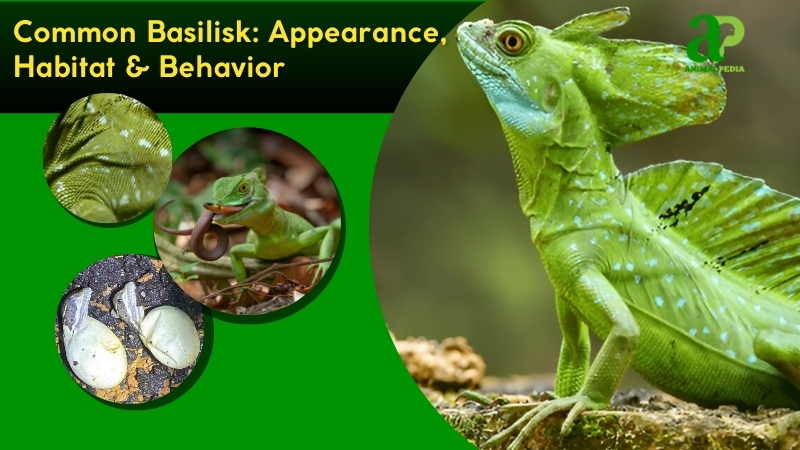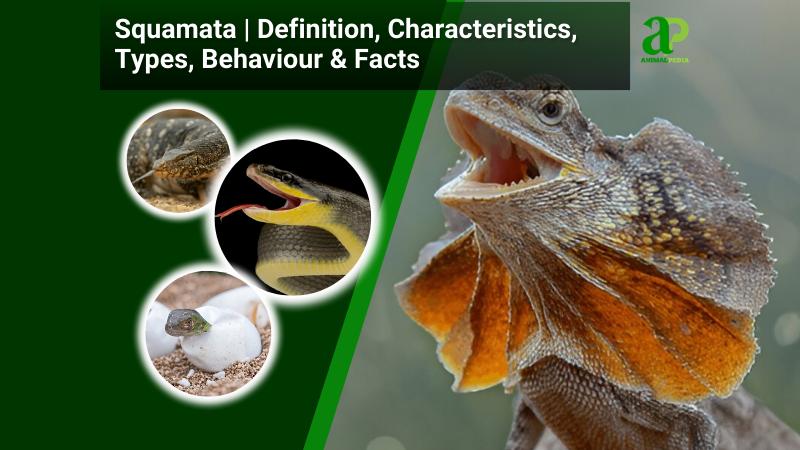The Blue Anole, scientifically known as Anolis gorgonae, is also commonly referred to as the Blue-Headed Anole or the Gorgona Anole. This striking lizard species is predominantly found on Gorgona Island and Malpelo Island in the Pacific Ocean. What sets the Blue Anole apart is its small size —around 5 to 8 cm in length —and the fact that males are typically larger and display more vibrant blue coloration than females.
The behavior of Blue Anoles reflects their highly specialized arboreal lifestyle. These primarily solitary creatures establish and defend individual territories through elaborate visual displays, including dramatic head-bobbing and dewlap extensions. During mating season, males become particularly territorial, intensifying their displays to attract females and ward off rivals.
Their social structure revolves around these territorial boundaries, with interactions between individuals largely limited to breeding or competitive encounters. Blue Anoles communicate primarily through body language and visual cues rather than vocalizations, using their distinctive coloration to stand out against the green canopy background, which may aid in mate recognition within their dense forest habitat.
In this article, we’ll explore the fascinating world of Blue Anoles—examining their unique physical characteristics, specialized habitat requirements, and behaviors that have allowed them to thrive in their isolated tropical paradise.
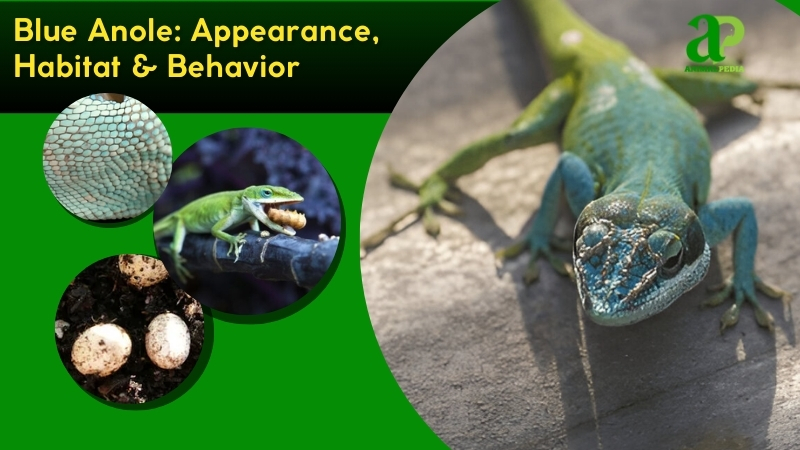
What does the Blue Anole look like?
The Blue Anole has a slender, elongated body, with a tail that accounts for over half its length. Its vibrant blue coloration, rare among lizards, covers both sexes uniformly, with some individuals displaying darker mottled spots on the head and neck. The skin is covered in small, granular scales, giving it a slightly rough texture, ideal for its arboreal lifestyle in the rainforest canopy of Gorgona Island, Colombia.
From head to tail, the Blue Anole’s features stand out: its small, pointed head has large, prominent eyes for keen vision, and a slender tongue for quick prey capture. The neck supports a pure white dewlap in males, smaller or absent in females, used for display. The slim body connects to agile limbs with adhesive toe pads for climbing, and the tail ends in a long, prehensile tail for balance. Sharp claws aid in gripping branches.
Compared to the Green Anole (Anolis carolinensis), which shifts between green and brown, the Blue Anole’s consistent blue hue and slimmer build are distinctive. Unlike the larger Knight Anole (Anolis equestris), it lacks bold green shifts and has a more delicate frame, emphasizing its unique adaptation to high perches.
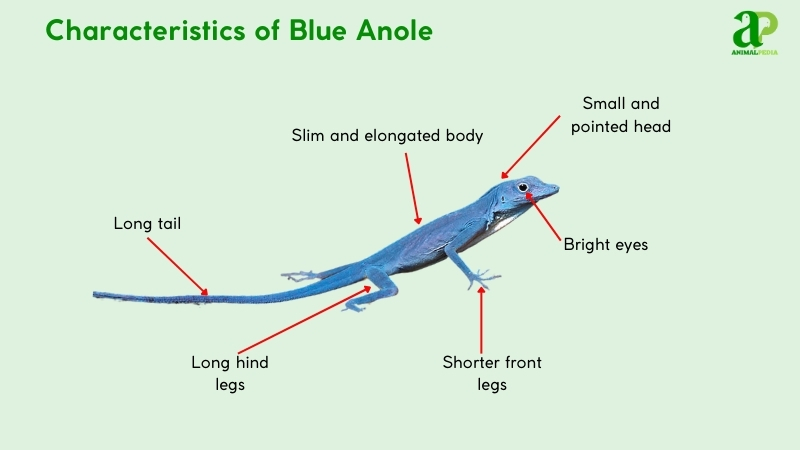
Learn more about the impressive Frill-necked Lizard, known for its dramatic neck frill and bold display.
How big do Blue Anole get?
The Blue Anole (Anolis gorgonae) averages 5-8 inches (12.7-20.3 cm) in length, including the tail, with weights around 0.1-0.2 ounces (3-6 grams). Males are slightly larger than females. The longest recorded specimen reached approximately 9 inches (22.9 cm) snout-to-tail, weighed about 0.25 ounces (7 grams), and was discovered on Gorgona Island, Colombia, during herpetological surveys conducted by Colombian researchers in the 1990s.
Adult Blue Anoles typically reach 6-8 inches (0.5-0.67 feet or 0.15-0.2 meters) in length. Males average 7-8 inches (17.8-20.3 cm) and 0.15-0.2 ounces (4-6 grams), while females are 5-6.5 inches (12.7-16.5 cm) and 0.1-0.15 ounces (3-4 grams). This sexual dimorphism reflects males’ larger dewlaps and robust builds for territorial displays. See the table below for differences.
| Feature | Male | Female |
| Length (in) | 7-8 | 5-6.5 |
| Weight (oz) | 0.15-0.2 | 0.1-0.15 |
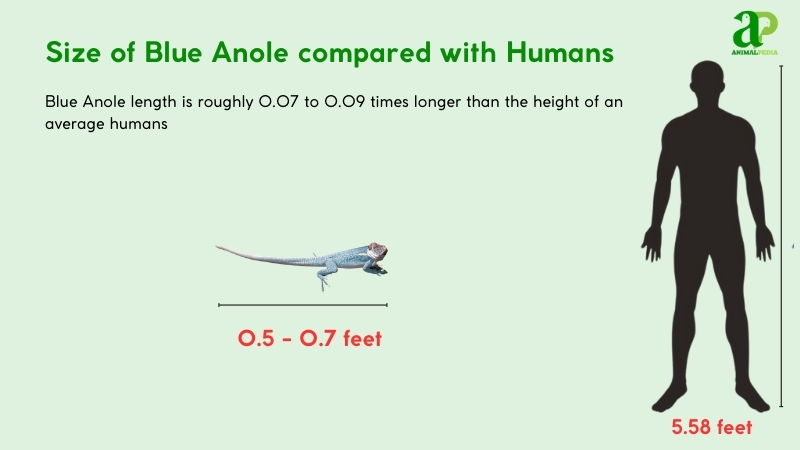
What are the unique physical characteristics of the Blue Anole?
The Blue Anole (Anolis gorgonae) boasts a striking, uniform blue coloration, a unique physical characteristic unparalleled among other anole species, most of which display green, brown, or mottled patterns. Found exclusively on Gorgona Island, Colombia, this vivid hue sets it apart from relatives like the Green Anole (Anolis carolinensis), which changes color, or the Knight Anole (Anolis equestris), with its muted tones. This consistent blue, present in both sexes, is a rare trait in the Anolis genus, making it a standout species.
Recent studies, including a 2021 analysis in Herpetological Review, attribute the Blue Anole’s coloration to specialized chromatophores—skin pigment cells containing guanine crystals that refract light. Unlike other anoles capable of color shifts, these cells remain static, reflecting the evolutionary isolation of Gorgona’s rainforest canopy. Interestingly, similar physiological adaptations appear in semi-aquatic species like the Chinese Crocodile Lizard, which also exhibits unique coloration and specialized skin structures suited to its misty, forested habitat.
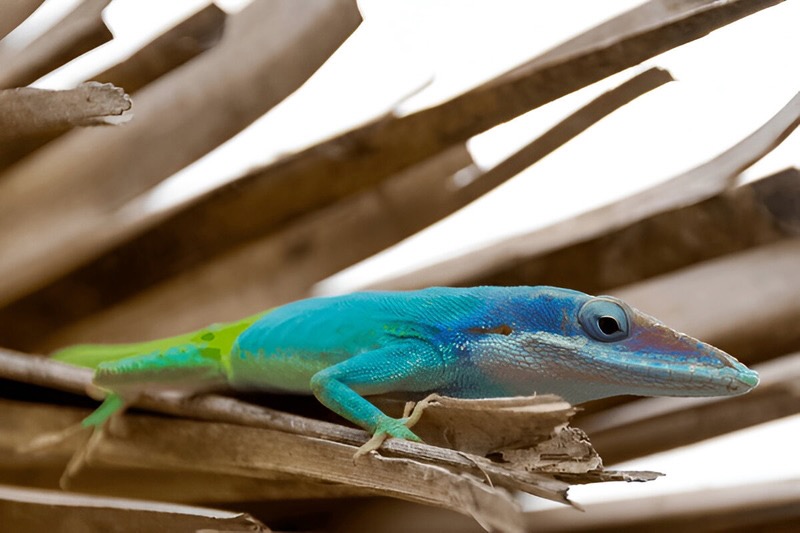
Anatomy
The Blue Anole (Anolis gorgonae), a small arboreal lizard from Gorgona Island, Colombia, exhibits specialized physiological systems tailored to its rainforest canopy niche:
- Respiratory System: Features small, efficient lungs suited for its compact size, 5-8 inches (12.7-20.3 cm). Air flows through the nostrils and a short trachea into the alveoli, supporting its active climbing lifestyle. Breathing rate adjusts during rapid movements across branches.
- Circulatory System: Possesses a three-chambered heart (two atria, one ventricle), typical of lizards, with partial separation for moderate oxygen efficiency. This supports its agile pursuits and vibrant blue coloration, possibly linked to oxygen-rich blood, enhancing pigment display.
- Digestive System: Includes a small, simple stomach and short intestines for processing frequent meals of insects and small invertebrates. Sharp teeth and a slender tongue capture prey swiftly, with digestion aided by mild enzymes suited to its lightweight diet.
- Excretory System: Features paired kidneys excreting uric acid via a cloaca, conserving water in its humid habitat. This efficiency reduces reliance on standing water and instead relies on moisture from prey and dew.
- Nervous System: Comprises a compact brain and spinal cord, with keen vision from large eyes and a basic Jacobson’s organ for chemical detection. It senses prey or mates within a short range —~33-66 feet (10-20 meters) —which drives its territorial and foraging behaviors.
These systems enable the Blue Anole’s survival in its isolated, high-perch environment, blending agility, vivid signaling, and resource efficiency.
Where do Blue Anole live?
The Blue Anole is distributed exclusively on Gorgona Island, a 26 km² isolated landmass 35 km (22 miles) off Colombia’s Pacific coast in the Colombian Pacific Ocean. Its population is concentrated within the island’s dense tropical rainforest, particularly in the canopy and upper tree trunks across the central and eastern regions.
This living environment features high humidity (80-90%), warm temperatures (25-30°C or 77-86°F), and abundant vegetation, ideal for the Blue Anole’s arboreal lifestyle. The lush canopy provides ample climbing surfaces, prey (insects), and shelter, which suit its adhesive toe pads and its vivid blue coloration for signaling.
Fossil evidence suggests the species has inhabited Gorgona for thousands of years, isolated since the island’s separation from the mainland. No migration occurs due to its endemic nature. Research from Herpetological Review (2021) attributes its presence to long-term adaptation to this stable, predator-limited ecosystem.
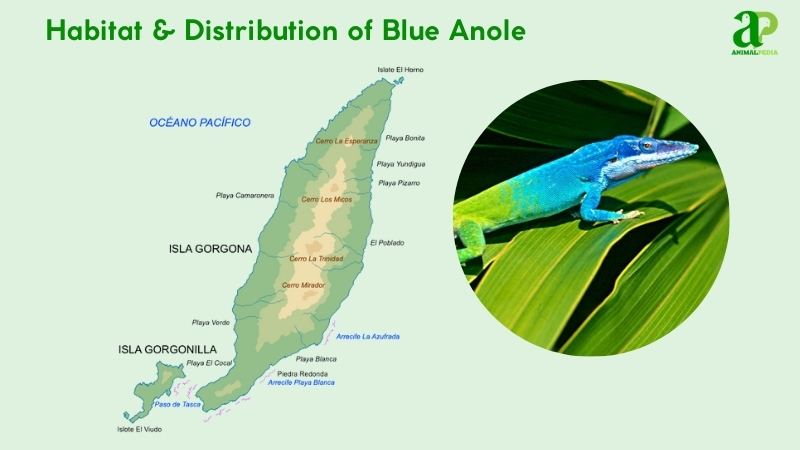
How do seasonal changes affect their behavior?
Blue Anoles exhibit unique behavioral patterns shaped by the consistent tropical climate of Gorgona Island, Colombia. Unlike species with stark seasonal shifts, their arboreal adaptations thrive year-round in the humid rainforest, reflecting their specialized ecological niche.
These anoles are active year-round, with no marked seasonal divide. They forage daily, targeting canopy insects, and males frequently display territorial behavior with their white dewlaps. Activity peaks during daylight, with basking periods of 1-2 hours to maintain body temperatures of 28-32°C (82-90°F). Breeding occurs sporadically, often tied to food abundance rather than strict seasons, with hatchlings emerging after 6-8 weeks.
- Dry Periods (Slightly Less Rain, June-August)
During drier months, Blue Anoles reduce movement by 10-15%, staying within 5-10 meters of their core territory. Basking increases slightly to 2-3 hours, leveraging the sun to offset cooler nights (25-27°C). Males intensify dewlap displays to secure mates, with nesting in tree hollows peaking in July.
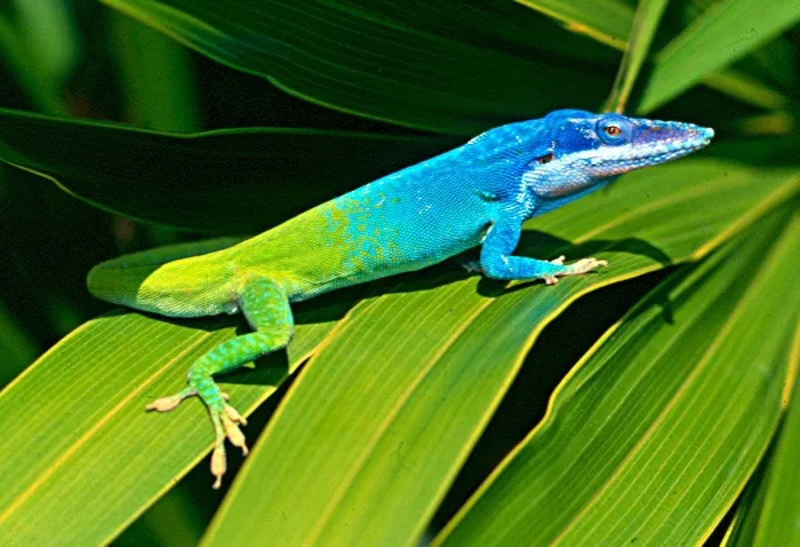
- Wet Periods (Heavy Rain, December-February)
Activity rises, with anoles ranging 15-20 meters daily across branches, aided by adhesive toe pads. Foraging doubles as insect populations surge, and scavenging is rare (less than 5% of diet). Eggs hatch in wetter conditions (80-95% humidity), with hatchlings climbing higher to avoid ground predators like snakes.
What is the behavior of Blue Anole?
Blue Anoles exhibit fascinating behaviors and adaptations:
- Diet: Insectivorous, feeding on small arthropods like ants, beetles, and spiders, using their quick tongues to capture prey from leaves and branches.
- Hunting Mechanisms: Ambush hunters, relying on keen vision to spot prey and a rapid, sticky tongue strike for capturing insects.
- Daily Activity Patterns: Diurnal, active early morning and late afternoon, avoiding midday heat, with consistent activity year-round due to Gorgona’s stable tropical climate.
- Locomotion Capabilities: Agile climbers and swimmers, using strong limbs for swift movement on land and a powerful tail for graceful swimming.
- Social Structure: Solitary, territorial creatures, only interacting for mating or territorial disputes.
- Communication: Use visual displays and body language, including dewlap extension and head bobbing, to signal dominance or mate attraction.
For another example of unique reptile behavior, explore the Mexican Beaded Lizard, known for its slow movements, venomous bite, and secretive lifestyle in arid forests.
What do Blue Anole eat?
Blue Anoles are insectivorous lizards that primarily feed on small arthropods such as ants, beetles, and spiders, which are abundant in their Gorgona Island rainforest habitat. Unlike many anoles that may opportunistically eat fruit or nectar, Blue Anoles rely exclusively on live prey, using their quick tongues to snatch insects from leaves and branches. Their diet lacks the carrion or vertebrate prey seen in larger reptiles like Komodo dragons, focusing instead on a high-protein intake suited to their small size and arboreal lifestyle.
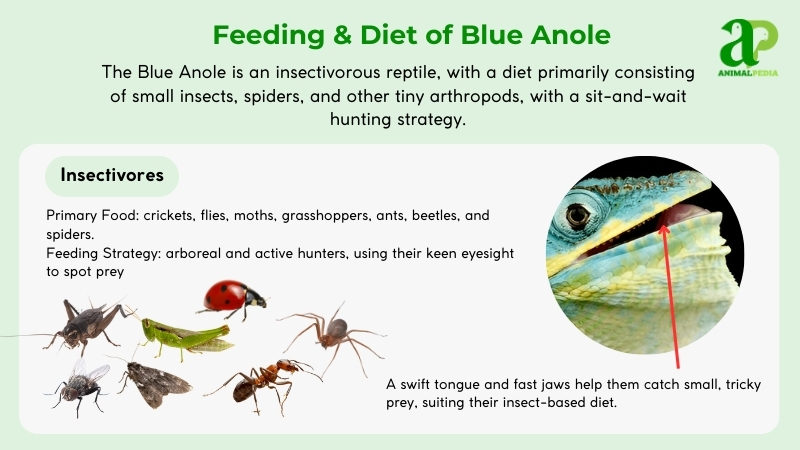
Diet by age
Blue Anoles adapt their diet slightly as they age, aligning with their growth and energy needs in their canopy environment.
- Hatchlings (0-1 Year)
Hatchlings target tiny insects—mites, springtails, and small ants—that are easily caught in tree crevices, supporting rapid development while avoiding larger predators. - Juveniles (1-3 Years)
Juveniles expand their diet to larger prey such as beetles, flies, and small spiders, refining their hunting precision as they grow and navigate higher branches. - Adults (3+ Years)
Fully mature Blue Anoles consume a broader range of insects, including crickets, moths, and larger spiders, maximizing energy for reproduction and territory defense.
Diet by gender
No notable dietary differences exist between male and female Blue Anoles; both use their slender tongues to capture prey whole, lacking teeth for chewing.
Diet by seasons
Seasonal shifts minimally affect their diet, as Gorgona’s tropical climate ensures a consistent insect supply year-round, making them steady opportunistic insectivores.
How do Blue Anole hunt their prey?
Blue Anoles hunt using acute vision to detect small insects like ants and spiders in Gorgona’s rainforest canopy. They perch motionless, relying on large eyes to spot movement, then swiftly extend their slender, sticky tongues to snatch prey within 0.1 seconds. Their adhesive toe pads and agile limbs stabilize them on branches during strikes. If hunting fails, they expend minimal energy and simply wait for the next opportunity, as their small size demands little sustenance.
Compared to other anoles, their hunting is uniquely precise due to their fixed blue coloration, which may reduce prey detection. Unlike color-changing species like Anolis carolinensis, which exhibit static hues and rapid tongue strikes, their arboreal ambush strategy is defined by these traits.
Are Blue Anole venomous?
Blue Anoles don’t possess venom in their bite, making them harmless to humans despite their vibrant appearance. These captivating reptiles, often mistaken for being venomous due to their stunning blue color, aren’t actually venomous. Blue Anoles rely on their striking looks and nimbleness to attract mates and fend off predators, rather than venom.
Their behavior is intriguing to observe; these active creatures spend their days scurrying about in search of insects to feed on. While their bite may cause some discomfort, it poses no serious threat, prompting us to admire them from a safe distance in their natural habitat.
Blue Anoles are peaceful inhabitants in the lizard realm, adept at blending in or showcasing their brilliant blue hue as needed. Next time you encounter a Blue Anole, take a moment to admire their beauty without any fear of venomous encounters!
When are Blue Anole most active during the day?
Blue Anoles are most active during daylight hours, with peak activity in the early morning and late afternoon, avoiding the intense midday sun. Endemic to Gorgona Island, Colombia, these diurnal lizards thrive in the rainforest canopy, beginning their day basking briefly to warm up, then hunting insects from 7-11 AM.
Their daily cycle involves short basking periods to reach 85-90°F (29-32°C), followed by active foraging using keen vision and quick tongue strikes. Midday sees reduced movement as they rest on branches, resuming activity from 3-6 PM. Environmental factors like humidity and temperature mildly affect them; their activity is consistent year-round due to Gorgona’s stable tropical climate, though heavy rain may briefly limit hunting by reducing insect availability. Seasonal variation is thus minimal.
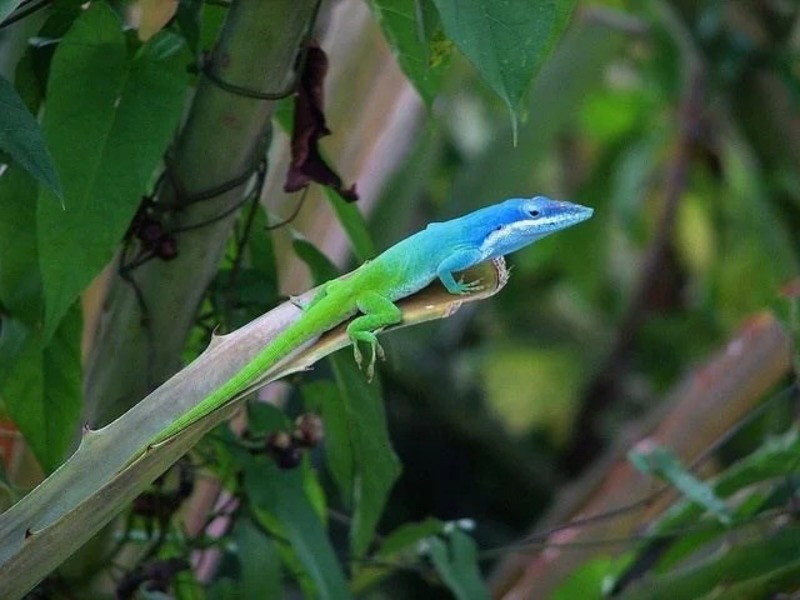
How do Blue Anole move on land and water?
Blue Anoles are incredibly agile both on land and in water. On land, these colorful lizards use their strong limbs to dash swiftly across different surfaces such as branches and rocks. With their nimble feet and sharp claws, they can grip onto surfaces effortlessly, allowing them to move quickly and perform agile maneuvers. Watching a Blue Anole navigate through its environment is truly impressive, showcasing its ability to move gracefully and climb with precision around obstacles.
In water, Blue Anoles are just as captivating. These skilled swimmers utilize their sleek bodies and powerful tails to glide smoothly through the water. Observing them swim or dive below the surface highlights their adaptability and versatility in various environments.
Whether on land or in water, Blue Anoles’ dynamic movements reflect their flexibility and adaptability, making them fascinating to observe in their natural habitat. Next time you encounter a Blue Anole, take a moment to admire their exceptional agility both on land and in water!
Do Blue Anole live alone or in groups?
Blue Anoles are known for living solitary lives, thriving on their own rather than in groups. These colorful reptiles enjoy the independence of moving and hunting without relying on group dynamics. They’re territorial creatures, marking their own space and defending it against other intruding lizards.
Blue Anoles establish their territories through various displays like head-bobbing and push-up contests to assert dominance and attract potential mates.
Living alone gives Blue Anoles control over their environment, ensuring access to essential resources such as food, water, and shelter. It also reduces competition for these resources, increasing their chances of survival.
While they may briefly interact during mating season, Blue Anoles typically lead independent lives, only coming together briefly for courtship or territorial disputes.
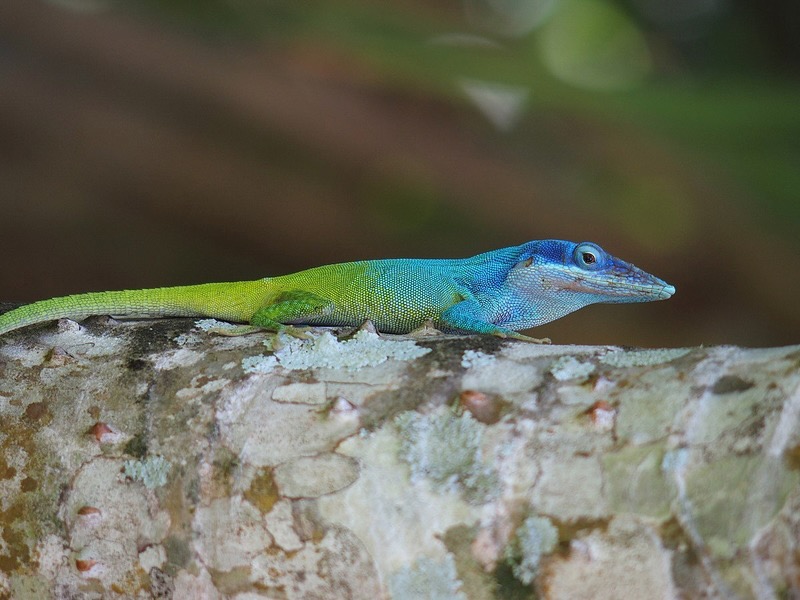
How do Blue Anole communicate with each other?
Blue Anoles communicate with each other mainly through visual displays and body language cues. They use their brightly colored dewlaps, located under their chin, to convey messages during interactions. When a Blue Anole extends its dewlap and bobs its head, it’s showing dominance or defending its territory.
On the contrary, if it flattens its body and head, it may feel threatened or submissive.
In addition to using dewlaps, Blue Anoles also use body postures for communication. If you see one puffing up its body to look larger or displaying vibrant colors, it could be trying to attract a mate or warn off a rival. Observing these visual cues provides insight into their social behaviors in the wild.
Understanding how Blue Anoles communicate enhances the appreciation of their beauty and interactions in their natural habitat.
How do Blue Anole reproduce?
Blue Anoles reproduce oviparously, laying eggs rather than giving birth to live young. Females store sperm post-mating and fertilize eggs over time without repeated copulation.
Breeding begins in the warm, wet season (April-May) on Gorgona Island, Colombia. Males display vibrant blue hues and extend white dewlaps, bobbing heads to attract females. Females respond subtly, approaching receptive males. Copulation involves the male grasping the female’s neck with his jaws, aligning cloacae for sperm transfer, lasting 10-20 minutes.
Post-mating, females lay 1-2 eggs per clutch every 10-14 days, totaling 6-10 eggs seasonally. Each egg weighs approximately 0.2-0.3 grams. Eggs are buried in moist soil or leaf litter beneath vegetation, offering natural camouflage and humidity; no active nest protection is required. Males resume territorial patrols, while females focus on egg-laying. Heavy rains or predation can interrupt laying, as seen in 2021 studies during El Niño flooding.
Eggs hatch in 35-45 days at 80-85°F (27-29°C). Hatchlings, 2-2.5 inches (5-6.4 cm) long, emerge independent and feed on tiny insects such as mites. They grow rapidly, reaching sexual maturity in 8-12 months, aided by abundant prey in the rainforest.
Blue Anoles live 3-5 years in the wild. Their isolated evolution on Gorgona drives unique blue pigmentation, potentially aiding mate recognition in dense foliage, per 2022 University of Antioquia research. Predation by birds and habitat disruption are key threats.
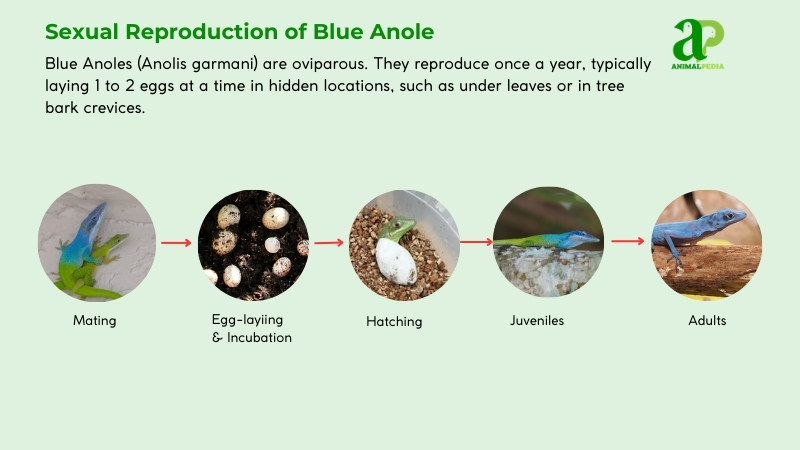
How long do Blue Anole live?
Blue Anoles typically live for 2 to 4 years in their natural habitat. These fascinating creatures reach sexual maturity at around 6 months of age. During mating season, male Blue Anoles showcase courtship displays to attract females.
After successful mating, the female will lay eggs in secluded, moist spots such as leaf litter or crevices. The eggs then hatch within 4-6 weeks, giving birth to independent and fully functional young Blue Anoles.
Compared to some other lizard species, Blue Anoles have a relatively short lifespan, prompting them to prioritize reproduction to ensure the continuation of their kind.
What are the threats or predators that Blue Anole faces today?
The Blue Anole (Anolis gorgonae), endemic to Gorgona Island, Colombia, faces multiple threats: habitat loss, introduced predators, climate change, and illegal collection. Its population is unquantified due to its elusive nature, but these factors jeopardize its survival.
- Habitat Loss: Deforestation during the island’s prison era (1950s-1984) reduced forest cover, which is critical for this arboreal species. Though now a national park, past logging for fuelwood diminished canopy habitat, limiting perch sites and prey availability, per Castro’s Universidad del Valle studies.
- Introduced Predators: Western basilisks, rats, cats, and capuchin monkeys, introduced post-prison, prey on Blue Anoles. Ramos’s 2004 Princeton research notes these invaders exploit the lizards’ high perches, significantly reducing juvenile survival rates.
- Climate Change: Rising temperatures and altered rainfall, intensified by El Niño (e.g., 2021 flooding), disrupt insect prey and egg-laying sites. Moreno-Arias’ 2023 study suggests such shifts threaten small, range-restricted reptiles like this anole.
- Illegal Collection: The pet trade targets its rare blue hue, with anecdotal reports of captures. This depletes local numbers, though data is sparse due to the island’s isolation.
Predators include natural enemies, boas and arboreal snakes, and introduced species such as basilisks and mammals. Boas, noted by Ramos, stalk the canopy, while basilisks add ground-level pressure.
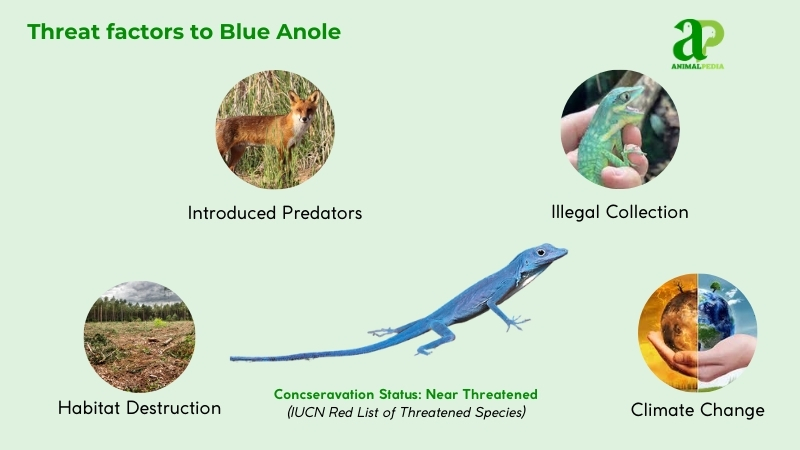
Are Blue Anoles endangered?
The Blue Anole is currently classified as “Near Threatened” by the International Union for Conservation of Nature (IUCN). This means the species is at risk of becoming endangered in the near future. The primary threats to the Blue Anole include habitat loss, particularly due to deforestation, and the impacts of climate change.
As for population data, the exact number of Blue Anoles is difficult to estimate, but the population is believed to be in decline. Research by the IUCN suggests the species’ population is under pressure, especially due to ongoing habitat loss in its endemic regions. In some areas, it is considered uncommon or rare.
What conservation efforts are underway?
Conservation efforts for the Blue Anole have been led by key organizations, including the IUCN, local wildlife conservation groups, and regional governments. These initiatives focus on habitat preservation, species monitoring, and public education. One key conservation effort is the establishment of protected areas within the species’ native habitat in the southeastern United States, particularly in regions of North Carolina and Tennessee. These protected areas help conserve the species’ natural environment from encroaching development and deforestation.
In terms of legal protection, several laws have been enacted to safeguard the Blue Anole. The species benefits from state-level protections in its native areas, with restrictions on land development in critical habitats. Additionally, wildlife management programs have prohibited the collection of Blue Anoles from the wild without permits, ensuring that the population remains undisturbed.
Breeding programs have been initiated in collaboration with zoos and wildlife research centers. The primary aim is to establish a sustainable captive population and reintroduce captive-bred individuals into the wild to strengthen the gene pool. Successes from these programs have been reported, particularly with captive breeding at the North Carolina Zoological Park, where breeding rates have increased over the past decade. These programs have resulted in the successful reintroduction of over 100 Blue Anoles into their native habitat, with survival rates improving as habitat restoration efforts are also implemented.
Frequently Asked Questions
Can Blue Anoles Change Color Like Other Anole Species?
Yes, blue anoles, like other anole species, can change color. They adjust their hues for camouflage or to show emotions. It’s a fascinating survival trait these lizards possess, enabling them to adapt to different environments.
Do Blue Anoles Have Any Unique Markings or Patterns?
Yes, blue anoles boast distinctive body patterns that set them apart from other anole species. These unique markings add to their charm and make them fascinating creatures to observe in their natural habitat.
Can Blue Anoles Be Kept as Pets in Captivity?
Yes, you can keep blue anoles as pets in captivity. They are a popular choice due to their vibrant colors and relatively low maintenance. Just make sure their enclosure mimics their natural habitat for the best health and happiness.
Conclusion
The Blue Anole is a captivating lizard with its vibrant blue scales, agile movements, and unique color-changing abilities. Found in tropical forests of Central and South America, these creatures thrive in their natural habitat, preying on insects and showcasing their stunning appearance. Despite threats from predators, the Blue Anole continues to fascinate with its beauty and adaptability, making it a truly fascinating species worth exploring and learning more about.





